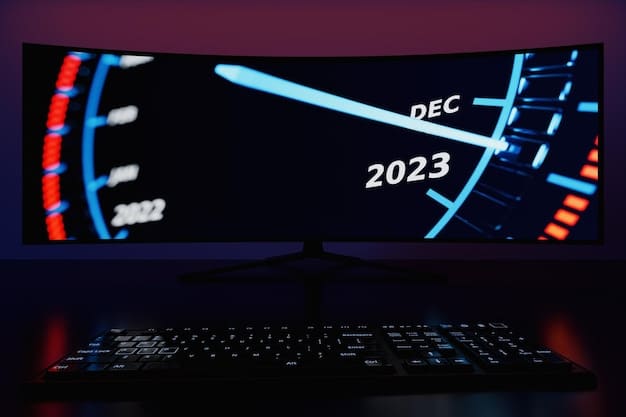4K Streaming Guide: Optimize for Best Visuals in the US

Demystifying 4K streaming involves optimizing your equipment, internet speed, and streaming service settings to fully enjoy the crystal-clear visuals on your 4K screen right here in the US.
Ready to dive into the world of stunning, ultra-high-definition entertainment? This guide simplifies everything you need to know about 4K Streaming Demystified: Optimizing Your Setup for the Best Visual Experience in the US, from selecting the right equipment to tweaking your settings for the ultimate picture quality.
Understanding 4K Streaming Technology
4K streaming has revolutionized how we consume content, transforming our living rooms into personal cinemas. However, to truly appreciate this technology, understanding the nuances behind it is essential.
Let’s start by exploring the core aspects of 4K resolution contrasted with older standards and understanding the required bandwidth.
4K Resolution vs. Older Standards
4K, also known as Ultra High Definition (UHD), showcases approximately four times the pixels of standard 1080p High Definition (HD). That’s close to eight million pixels against just two million, delivering significantly more detail, sharpness, and clarity.
But the difference is more than just numbers.
- Enhanced Clarity: Fine details in textures, patterns are visible.
- Greater Depth: Creating a more lifelike and immersive viewing experience.
- Larger Screen Compatibility: 4K shines best on larger screens where the pixel density really makes a difference.
The upgrade from 1080p to 4K gives audiences a substantial boost in visual fidelity, especially noteworthy from a distance.
Bandwidth Requirements for 4K Streaming
Streaming 4K content demands a robust and stable internet connection. Not all internet plans are created equal, and understanding bandwidth needs is critical. Here’s what you need to know:
Most streaming services recommend a minimum download speed of 25 Mbps for smooth 4K streaming. However, actual requirements can vary based on the provider and also the specific content you are watching.

To guarantee uninterrupted 4K streaming, a speed closer to 40-50 Mbps is often preferable, especially if multiple devices in your home are using the internet simultaneously.
To successfully enjoy 4K streaming, one ought to assess the bandwidth, verify the plan, and optimize network settings to accommodate high-bandwidth content.
Essential Equipment for 4K Streaming
To properly experience 4K streaming, having the appropriate equipment is key. The right TV and streaming device make all the difference. Consider HDR support, and compatible HDMI cables.
Let’s explore each.
Choosing a 4K TV
Selecting a 4K TV isn’t as straightforward as it seems. Resolution is only one aspect; other features greatly affect picture quality. Key considerations include:
- HDR (High Dynamic Range) Support: Enhances contrast and color accuracy.
- Screen Size: Larger screens maximize the 4K resolution benefits.
- Refresh Rate: Higher refresh rates (120Hz) reduce motion blur in fast-paced scenes.
Investigating these features ensures you get the most from your 4K experience.
Selecting a 4K Streaming Device
A streaming device acts as the hub that delivers content from services like Netflix or Amazon Prime. Choose a device that supports 4K streaming and HDR. Popular choices include:
The market provides various devices to satisfy diverse user needs. It’s a matter of doing some research to find the best one.
The Importance of HDMI Cables
Don’t overlook HDMI cables; they are crucial for transferring 4K content. Standard HDMI cables may be unable to handle the high bandwidth needed for 4K, potentially leading to:
- Flickering: Intermittent signal loss.
- Color Distortion: Compromised color fidelity.
- Complete Signal Loss: The screen goes blank.
Using “Premium High-Speed” HDMI cables assures that the signal passes without issues.
Purchasing the right equipment means you are well on your way to enjoying 4K content.
Optimizing Your Streaming Service Settings
Even with the perfect equipment, tweaking your streaming service settings is essential for achieving the best 4K picture. Each service varies, but the basics of making informed selections are universal.
Let’s see how one can adjust playback settings and find 4K content.
Adjusting Playback Settings for 4K Quality
Most streaming services don’t default to the highest quality. You usually need to manually change the settings to enable 4K streaming. Here’s how:
The exact steps can vary, but the goal is to find the playback settings and select the highest resolution available. Not taking steps to increase video quality may result in subpar viewing.
Finding 4K Content
Not all titles are available in 4K. Streaming services try to make things easy by categorizing 4K content clearly. Search options include:
- Dedicated 4K Sections: Many services have a 4K Ultra HD section.
- 4K Badges: Look for “4K” or “UHD” badges on movie listings.
- Search Filters: Use available filters to narrow down 4K titles.
Searching and filtering ensures that you are watching in the highest resolution.
Getting the best 4K picture means one should manually change the settings to enable 4K streaming so you can enjoy your movies and shows.

Troubleshooting Common 4K Streaming Issues
Even with a great setup, you might encounter playback problems. Buffering, resolution downgrades, and compatibility issues are common. Let’s explore troubleshooting ideas.
From adjusting equipment, checking connections, assessing playback speed, many fixes exist.
Buffering and Playback Interruptions
Buffering, where the video pauses to load, disrupts the viewing experience. Common causes and solutions include:
These steps can mitigate several frequent issues.
Resolution Downgrades
Sometimes, the streaming resolution might drop unexpectedly. You want to check your settings. Potential causes include:
- Internet Speed Fluctuations: The service lowers resolution due to bandwidth issues.
- Device Limitations: A device might not support 4K consistently.
- Server Problems: The streaming service itself has outages.
Understanding why the resolution drops helps in diagnosing and finding the most suitable resolution.
Compatibility Issues
Compatibility issues can range from HDR incompatibility to codec errors. Important aspects include:
Doing this can make your streaming experience more pleasurable.
Maximizing Audio Quality for 4K Streaming
While visual quality is a major draw for 4K streaming, audio is just as important. High-resolution audio formats, proper setup, and troubleshooting guarantee a superb sound.
Let’s discover methods of maximizing audio quality.
Understanding High-Resolution Audio Formats
Several audio formats complement 4K visuals. Common formats include:
- Dolby Atmos: Immersive, object-based surround sound.
- DTS:X: Competing immersive format with object-based audio.
- PCM (Pulse Code Modulation): Uncompressed audio for superior quality.
Choosing formats that match your equipment makes for a great experience.
Setting Up Your Audio System
Your audio setup dramatically impacts sound quality. Essential steps include:
A suitable configuration can enrich your audio experience substantially.
Troubleshooting Audio Problems
Audio issues can sometimes occur, like missing sound, syncing problems, or poor quality. Here are the fixes:
Taking care of each of the settings makes for an enjoyable audio experience.
The Future of 4K Streaming in the US
4K streaming is continuously becoming a norm in the United States. Technological advancements, like improved bandwidth and enhanced compression algorithms, promise an even smoother and more accessible future.
Let’s look at trends and predictions.
Emerging Trends in Streaming Technology
Several emerging trends are set to reshape the 4K streaming landscape:
- 8K Streaming: While still niche, 8K is slowly becoming a talking point.
- AV1 Codec: More efficient compression that uses less bandwidth.
- Interactive Streaming: Features like watch parties and interactive content.
These innovations will soon become more widely seen.
Predictions for 4K Streaming Adoption
Predictions for 4K streaming adoption show a steady increase in the US. Factors contributing to this growth include:
Making for a great viewing experience.
| Key Point | Brief Description |
|---|---|
| 📺 4K TV | Choose a 4K TV with HDR and a high refresh rate for the best picture. |
| 🚀 Bandwidth | Ensure you have at least 25 Mbps for smooth 4K streaming. |
| ⚙️ Settings | Adjust your streaming service settings to ensure 4K quality is enabled. |
| 🛠️ Cables | Use “Premium High-Speed” HDMI cables for a stable 4K signal. |
FAQ Section
▼
For uninterrupted 4K streaming in the US, it’s recommended to have a minimum download speed of 25 Mbps, but a speed of 40-50 Mbps is often preferable, especially if multiple devices are using the internet.
▼
Most streaming services have a dedicated 4K Ultra HD section. Additionally, look for “4K” or “UHD” badges on the movie listings or use search filters to narrow down titles available in 4K.
▼
Yes, HDMI cables are critical for transferring 4K content. For a stable signal, use “Premium High-Speed” HDMI cables to ensure the higher bandwidth needed for 4K is fully supported.
▼
HDR, or High Dynamic Range, enhances the contrast and color accuracy of your 4K picture. It provides a wider range of colors and brighter highlights, resulting in a more lifelike viewing experience.
▼
Buffering issues can arise from slow internet speeds, too many devices sharing the same network, or an outdated streaming device. Try checking your connection and closing unused apps.
Conclusion
Optimizing your setup for 4K streaming involves mastering equipment, tweaking settings, and troubleshooting issues. As technology advances, US viewers can look forward to exciting developments, making home entertainment more immersive than ever.





